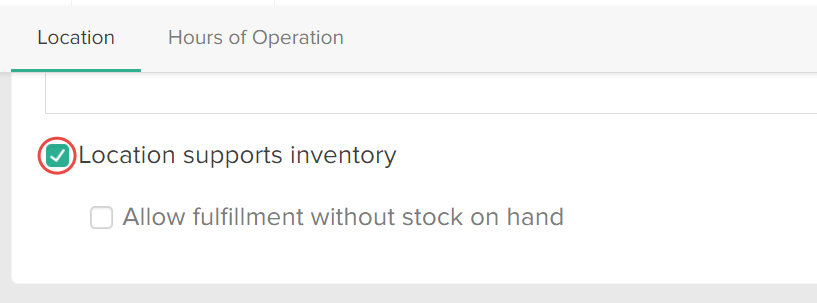You must enable inventory at the location level before you can begin to associate products with inventory.
Note that changes to these settings may not immediately take effect when processing orders. It may take up to 15 minutes for updates to be reflected in the system while the cache refreshes.
Enable Inventory
You must enable inventory support for one or more of your locations and then enable products for stock tracking before you can create inventory records and set quantities.
To enable inventory support for a location:
- Go to Main > Orders > Locations.
- Click a location to open its configuration details.
- Under the Location section, enable Location supports inventory.

- (Optional) Decide whether you want to Allow fulfillment without stock on hand.
This allows you to fulfill orders without sufficient on-hand quantities. This is useful if you want to mark items as fulfilled before entering newly arriving stock quantities in Kibo eCommerce. Refer to Fulfill Items Without Sufficient Stock for more information. - Click Save.
To enable inventory for a product in the catalog:
- Go to Main > Catalog > Products.
- Click a product to open its configuration details.
- Go to Product Editor > Inventory and enable Track stock level.

- Click Save.
Note that if you click Manage Inventory in the product configurations shown above, you will be taken to the Inventory UI filtered to that product. If it's a configurable product with options, then the base product code will be used.
Create Inventory Records
You can create inventory records and set quantities from the Inventory UI.
- Go to Main > Orders > Inventory.
- Click Create New Inventory. This will add an empty row to the table.

- Enter a product code and select a location, then enter the On Hand and any other inventory values you want to include such as LTD, Floor, Safety Stock or Excess Inventory Threshold. The below example shows a basic inventory record without additional granular inventory fields or tags.

If you want to set Safety Stock levels automatically upon inventory refreshes, based on criteria such as product types and location groups, you can use Safety Stock Rules.
- Click Save.
Adjust Inventory Quantities
You can adjust the On Hand, LTD, Floor, Safety Stock and Excess Inventory Threshold quantity of existing inventory records at any time via the Inventory UI. You can also update inventory quantities via the Refresh and Adjust APIs or inventory import process instead.
- Go to Main > Orders > Inventory.
- Either select the Location Name from the drop-down menu or enter a Product Code to view inventory levels.
- Expand the actions menu on the far right of an inventory row and click Edit. This will make the fields editable for you to enter a new quantity.
- Note that if the inventory record includes granular fields or tagged inventory, the total cannot be edited at the top level. You must update the quantity for a specific granular field or tag instead.

- Note that if the inventory record includes granular fields or tagged inventory, the total cannot be edited at the top level. You must update the quantity for a specific granular field or tag instead.
- Click Save.
Click Delete in the actions menu if you want to completely remove a record instead. If the inventory record includes granular fields or segmented tags, they will be removed as well.
By default, you can only update On Hand quantities and the system will calculate the appropriate Available amount. If you want to change this behavior so that you can directly edit the Available inventory value, contact Kibo Support to update your tenant configurations.




